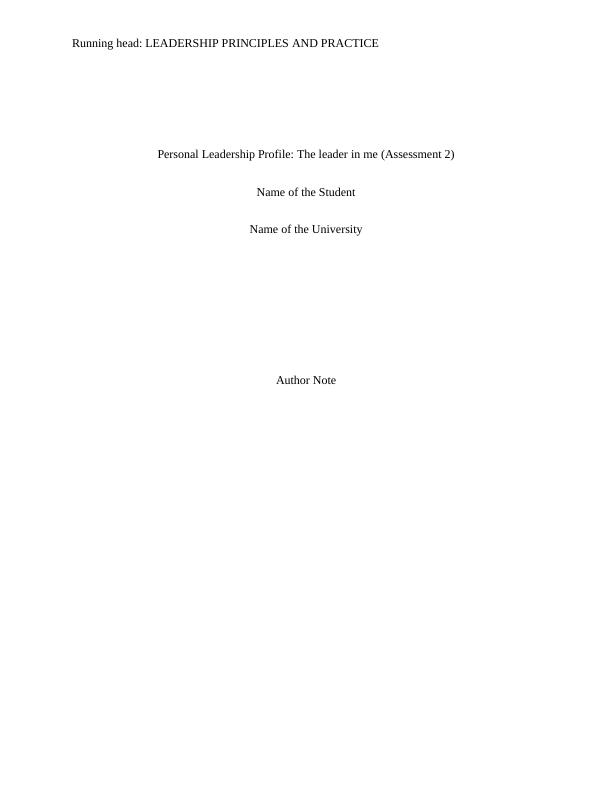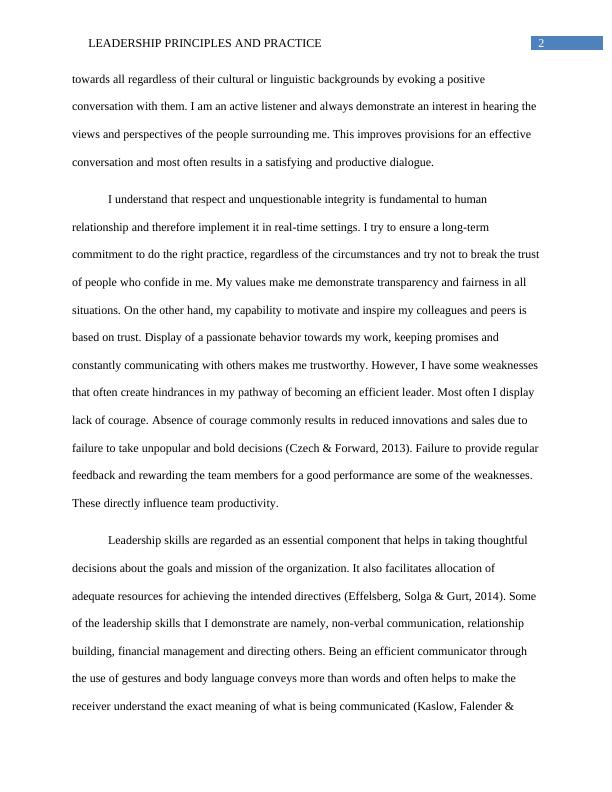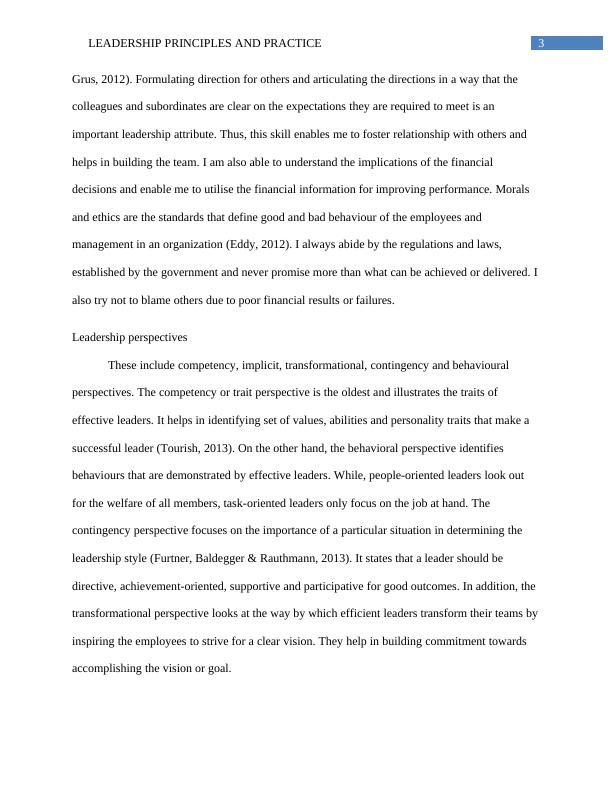Leadership Principles and Practice
Added on 2020-05-16
16 Pages4302 Words91 Views
Running head: LEADERSHIP PRINCIPLES AND PRACTICE
Personal Leadership Profile: The leader in me (Assessment 2)
Name of the Student
Name of the University
Author Note
Personal Leadership Profile: The leader in me (Assessment 2)
Name of the Student
Name of the University
Author Note

1LEADERSHIP PRINCIPLES AND PRACTICE
Personal Leadership and Profile
Identification of strengths and weaknesses forms the basis of the foundation of becoming
a successful and great leader. It refers to the ability to define a certain direction for personal life
as well as leadership, and move in that direction with clarity and consistence (Yukl, 2012). Being
clear on personal values, opinions and beliefs, and remaining grounded are imperative to the
pathway of becoming an efficient leader. Building on the strength and improving areas of
weakness, without being defensive and embarrassed are some of the key qualities of an effective
leader. Self-assessment and monitoring helped me recognize my abilities and helped me gain a
deeper understanding of my values, motives and actions (Batool, 2013). This assignment will
illustrate my leadership capabilities and will support the leadership styles I demonstrate using
relevant literatures.
Discussion
Personality characteristics
Core values of leadership involve certain guiding principles that play an essential role in
our lives. These values facilitate and guide others in making a positive difference in personal
lives, which in turn contributes to a larger good. Some of the most essential values that I
manifest are related to demonstration of respect, integrity, and trust. A culture of mutual respect
is vital owing to the fact that it helps people from belonging to different backgrounds come
forward and work together as a team (Klar & Brewer, 2013). Failure to demonstrate respect often
makes it difficult for the most secured people as well to bring about changes and innovation
(Carter & Greer, 2013). I am respectful towards all my colleagues and peers as it helps in
recognizing their basic needs and enhances the overall performance. I try to show respect
Personal Leadership and Profile
Identification of strengths and weaknesses forms the basis of the foundation of becoming
a successful and great leader. It refers to the ability to define a certain direction for personal life
as well as leadership, and move in that direction with clarity and consistence (Yukl, 2012). Being
clear on personal values, opinions and beliefs, and remaining grounded are imperative to the
pathway of becoming an efficient leader. Building on the strength and improving areas of
weakness, without being defensive and embarrassed are some of the key qualities of an effective
leader. Self-assessment and monitoring helped me recognize my abilities and helped me gain a
deeper understanding of my values, motives and actions (Batool, 2013). This assignment will
illustrate my leadership capabilities and will support the leadership styles I demonstrate using
relevant literatures.
Discussion
Personality characteristics
Core values of leadership involve certain guiding principles that play an essential role in
our lives. These values facilitate and guide others in making a positive difference in personal
lives, which in turn contributes to a larger good. Some of the most essential values that I
manifest are related to demonstration of respect, integrity, and trust. A culture of mutual respect
is vital owing to the fact that it helps people from belonging to different backgrounds come
forward and work together as a team (Klar & Brewer, 2013). Failure to demonstrate respect often
makes it difficult for the most secured people as well to bring about changes and innovation
(Carter & Greer, 2013). I am respectful towards all my colleagues and peers as it helps in
recognizing their basic needs and enhances the overall performance. I try to show respect

2LEADERSHIP PRINCIPLES AND PRACTICE
towards all regardless of their cultural or linguistic backgrounds by evoking a positive
conversation with them. I am an active listener and always demonstrate an interest in hearing the
views and perspectives of the people surrounding me. This improves provisions for an effective
conversation and most often results in a satisfying and productive dialogue.
I understand that respect and unquestionable integrity is fundamental to human
relationship and therefore implement it in real-time settings. I try to ensure a long-term
commitment to do the right practice, regardless of the circumstances and try not to break the trust
of people who confide in me. My values make me demonstrate transparency and fairness in all
situations. On the other hand, my capability to motivate and inspire my colleagues and peers is
based on trust. Display of a passionate behavior towards my work, keeping promises and
constantly communicating with others makes me trustworthy. However, I have some weaknesses
that often create hindrances in my pathway of becoming an efficient leader. Most often I display
lack of courage. Absence of courage commonly results in reduced innovations and sales due to
failure to take unpopular and bold decisions (Czech & Forward, 2013). Failure to provide regular
feedback and rewarding the team members for a good performance are some of the weaknesses.
These directly influence team productivity.
Leadership skills are regarded as an essential component that helps in taking thoughtful
decisions about the goals and mission of the organization. It also facilitates allocation of
adequate resources for achieving the intended directives (Effelsberg, Solga & Gurt, 2014). Some
of the leadership skills that I demonstrate are namely, non-verbal communication, relationship
building, financial management and directing others. Being an efficient communicator through
the use of gestures and body language conveys more than words and often helps to make the
receiver understand the exact meaning of what is being communicated (Kaslow, Falender &
towards all regardless of their cultural or linguistic backgrounds by evoking a positive
conversation with them. I am an active listener and always demonstrate an interest in hearing the
views and perspectives of the people surrounding me. This improves provisions for an effective
conversation and most often results in a satisfying and productive dialogue.
I understand that respect and unquestionable integrity is fundamental to human
relationship and therefore implement it in real-time settings. I try to ensure a long-term
commitment to do the right practice, regardless of the circumstances and try not to break the trust
of people who confide in me. My values make me demonstrate transparency and fairness in all
situations. On the other hand, my capability to motivate and inspire my colleagues and peers is
based on trust. Display of a passionate behavior towards my work, keeping promises and
constantly communicating with others makes me trustworthy. However, I have some weaknesses
that often create hindrances in my pathway of becoming an efficient leader. Most often I display
lack of courage. Absence of courage commonly results in reduced innovations and sales due to
failure to take unpopular and bold decisions (Czech & Forward, 2013). Failure to provide regular
feedback and rewarding the team members for a good performance are some of the weaknesses.
These directly influence team productivity.
Leadership skills are regarded as an essential component that helps in taking thoughtful
decisions about the goals and mission of the organization. It also facilitates allocation of
adequate resources for achieving the intended directives (Effelsberg, Solga & Gurt, 2014). Some
of the leadership skills that I demonstrate are namely, non-verbal communication, relationship
building, financial management and directing others. Being an efficient communicator through
the use of gestures and body language conveys more than words and often helps to make the
receiver understand the exact meaning of what is being communicated (Kaslow, Falender &

3LEADERSHIP PRINCIPLES AND PRACTICE
Grus, 2012). Formulating direction for others and articulating the directions in a way that the
colleagues and subordinates are clear on the expectations they are required to meet is an
important leadership attribute. Thus, this skill enables me to foster relationship with others and
helps in building the team. I am also able to understand the implications of the financial
decisions and enable me to utilise the financial information for improving performance. Morals
and ethics are the standards that define good and bad behaviour of the employees and
management in an organization (Eddy, 2012). I always abide by the regulations and laws,
established by the government and never promise more than what can be achieved or delivered. I
also try not to blame others due to poor financial results or failures.
Leadership perspectives
These include competency, implicit, transformational, contingency and behavioural
perspectives. The competency or trait perspective is the oldest and illustrates the traits of
effective leaders. It helps in identifying set of values, abilities and personality traits that make a
successful leader (Tourish, 2013). On the other hand, the behavioral perspective identifies
behaviours that are demonstrated by effective leaders. While, people-oriented leaders look out
for the welfare of all members, task-oriented leaders only focus on the job at hand. The
contingency perspective focuses on the importance of a particular situation in determining the
leadership style (Furtner, Baldegger & Rauthmann, 2013). It states that a leader should be
directive, achievement-oriented, supportive and participative for good outcomes. In addition, the
transformational perspective looks at the way by which efficient leaders transform their teams by
inspiring the employees to strive for a clear vision. They help in building commitment towards
accomplishing the vision or goal.
Grus, 2012). Formulating direction for others and articulating the directions in a way that the
colleagues and subordinates are clear on the expectations they are required to meet is an
important leadership attribute. Thus, this skill enables me to foster relationship with others and
helps in building the team. I am also able to understand the implications of the financial
decisions and enable me to utilise the financial information for improving performance. Morals
and ethics are the standards that define good and bad behaviour of the employees and
management in an organization (Eddy, 2012). I always abide by the regulations and laws,
established by the government and never promise more than what can be achieved or delivered. I
also try not to blame others due to poor financial results or failures.
Leadership perspectives
These include competency, implicit, transformational, contingency and behavioural
perspectives. The competency or trait perspective is the oldest and illustrates the traits of
effective leaders. It helps in identifying set of values, abilities and personality traits that make a
successful leader (Tourish, 2013). On the other hand, the behavioral perspective identifies
behaviours that are demonstrated by effective leaders. While, people-oriented leaders look out
for the welfare of all members, task-oriented leaders only focus on the job at hand. The
contingency perspective focuses on the importance of a particular situation in determining the
leadership style (Furtner, Baldegger & Rauthmann, 2013). It states that a leader should be
directive, achievement-oriented, supportive and participative for good outcomes. In addition, the
transformational perspective looks at the way by which efficient leaders transform their teams by
inspiring the employees to strive for a clear vision. They help in building commitment towards
accomplishing the vision or goal.

End of preview
Want to access all the pages? Upload your documents or become a member.
Related Documents
Personal Reflection on Leadership Developmentlg...
|3
|1012
|388
Leadershiplg...
|5
|723
|249
Health and Social care Workers Assignment PDFlg...
|7
|1678
|77
Being Enterprising: Personal Reflection and Analysis of Cornerstone as an Enterprising Organizationlg...
|5
|1320
|452
Professional Values in Health and Social Care -UNIT 4lg...
|6
|1510
|465
Journal of Education and Learninglg...
|8
|2050
|12